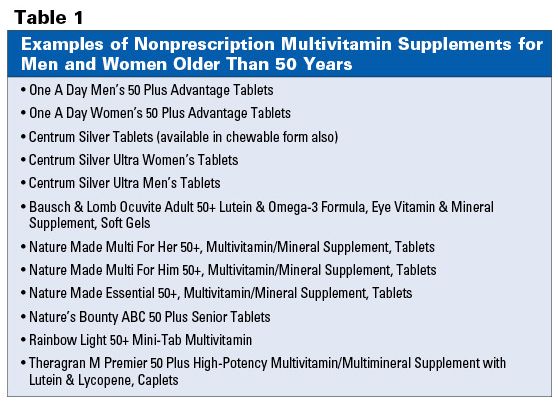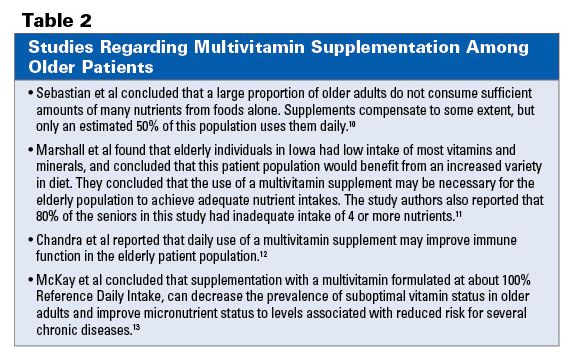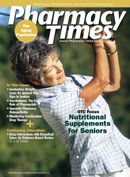Publication
Article
Pharmacy Times
Multivitamin/Multimineral Supplements: Meeting the Nutritional Needs of Older Patients
Author(s):
Many individuals can meet their nutritional needs through diet alone; however, some may find it difficult to do so and consider using a multivitamin/multimineral supplement.
Ms. Terrie is a clinical pharmacy writer based in Haymarket, Virginia.
Many individuals can meet their nutritional needs through diet alone; however, some may find it difficult to do so and consider using a multivitamin/ multimineral supplement. Among the elderly patient population, dietary supplements are one of the most commonly used OTC products.1 Studies report that deficiencies of vitamins and important minerals have been observed in almost one third of elderly patients.2 Older individuals are more likely to be at risk for nutritional deficiencies for a variety of reasons, such as lower caloric intake, poor nutrition, physical limitations, chewing difficulties, multiple medical conditions, lack of transportation, and limited income.3,4 Because older individuals are more likely to take several medications, various drug—nutrient reactions may occur, and the use of some pharmacologic agents may be associated with decreased appetite, therefore compromising nutritional status.
In the January 2008 issue of the Journal of Nutrition, researchers at Tufts University updated the food pyramid for older adults.5 The researchers wrote that, although the message of the food pyramid emphasizes meeting nutritional needs through dietary means rather than through the use of supplements, the flag on the top of the pyramid diagram is intended to alert older adults that they may need to augment the food sources of nutrients with specially fortified food products or a nutrient supplement containing vitamin D, calcium, or B12.5
Vitamin and Mineral Supplements for Older Men and Women
A variety of multivitamin/multimineral supplements formulated to meet the nutritional needs of individuals older than 50 years are available, including those aimed at the specific nutritional needs of men and women (Table 1). Examples of these formulations include Bayer One A Day Men’s 50 Plus Advantage and Women’s 50 Plus Advantage. In 2009, Wyeth Consumer Health introduced Centrum Silver Ultra Women’s and Centrum Silver Ultra Men’s supplements for those aged 50 years and older. In general, supplements formulated for those older than 50 years may include larger amounts of vitamin C, folic acid, vitamin D, vitamin E, vitamins B1, B2, B6, and B12, but no iron, as individuals in this patient population generally meet their iron needs through diet alone and require less in supplemental form.3,6-8 Some studies suggest that high iron stores may contribute to conditions such as cancer and cardiovascular disease; however, research to date is inconclusive.3,4,8 Formulations also may contain gingko biloba for improved memory and concentration.

In 2009, Nature’s Bounty introduced its new line of multivitamin/multimineral supplements geared for individuals older than 45 years, which is marketed as Your Life Multi Men’s 45+ and Your Life Multi Women’s 45+. These formulations contain 39 different nutrients, including 12 vegetable and fruit concentrates, antioxidants, probiotics, and omega-3 fatty acids.9 Various studies have investigated the effects of using a multivitamin supplement among those aged 50 years and older, and a summary of these results is shown in Table 2.

Before recommending any multivitamin/ multimineral supplement to older patients, pharmacists should assess medical history and medication profile to determine if there is a potential for contraindications to a supplement or the potential for any micronutrient—drug interactions. Patients should be reminded that these supplements are intended to prevent nutritional deficiencies and maintain nutritional stores: they are not intended for the self-treatment of vitamin deficiencies.3 Pharmacists should also determine if the patient is taking any other nutritional supplements to avoid duplication and refer patients for further medical evaluation when warranted. Patients should be reminded to take supplements as directed and to adhere to a nutritious diet consisting of a wide variety of foods that will ensure balanced and optimal nutrition for an active, healthy life.
For more information on the updated food pyramid for older adults, please visit http://nutrition.tufts.edu/docs/ guidelines.pdf.â–
References
1. Davidow L. Self care and nonprescription pharmacotherapy. In: Berardi R, Newton G, McDermott JH, et al, eds. Handbook of Nonprescription Drugs. 16th ed. Washington, DC: American Pharmacists Association; 2009:7.
2. Vitamins. MD Consult Web site. www.mdconsult.com/das/patient/body/168862454-5/911756995/10041/9477.html. Accessed November 1, 2009.
3. Huckleberry, Yvonne and Rollins, Carol. Essential and Conditionally Essential Nutrients. In: Berardi R, Newton G, McDermott JH, et al, eds. Handbook of Nonprescription Drugs. 16th ed. Washington, DC: American Pharmacists Association; 2009:389-417.
4.
Ervin RB
,
Kennedy-Stephenson J
. Mineral intakes of elderly adult supplement and nonsupplement users in the Third National Health and Nutrition Examination Survey. J Nutr. 2002;132(11):3422-7.
5. Lichtenstein AH,
Rasmussen H
,
Yu WW
,
Epstein SR
,
Russell RM
. Modified mypyramid for older adults.
J Nutr.
2008;138(1):5-11.
6. One A Day Vitamins [product information]. Bayer Consumer Web site. www.oneaday.com. Accessed October 25, 2009.
7. Centrum Silver [product information]. Wyeth Consumer Health Web site. www.centrum.com. Accessed October 25, 2009
8. Nature Made Vitamins [product information]. Pharmavite LLC Web site. www.naturemade.com. Accessed October 25, 2009.
9. Your Life Multivitamin [product information]. Nature’s Bounty Web site. www.naturesbounty.com/pages/whatsnew.aspx. Accessed October 30, 2009.
10.
Sebastian RS
,
Cleveland LE
,
Goldman JD
,
Moshfegh AJ
. Older adults who use vitamin/mineral supplements differ from nonusers in nutrient intake adequacy and dietary attitudes. J Am Diet Assoc. 2007;107(8):1322-1332.
11. Marshall TA et al. Inadequate nutrient intakes are common and are associated with low diet variety in rural, community-dwelling elderly. J Nutr. 2001;131(8):2192-2196.
12. Chandra RK. Effect of vitamin and trace-element supplementation on immune responses and infection in elderly subjects. Lancet. 1992;340(8828):1124-1127.
13. McKay DL, Perrone G, Rasmussen H, et al. The effects of a multivitamin/mineral supplement on micronutrient status, antioxidant capacity and cytokine production in healthy older adults consuming a fortified diet. J Am Coll Nutr. 2000;19(5):613-621.







